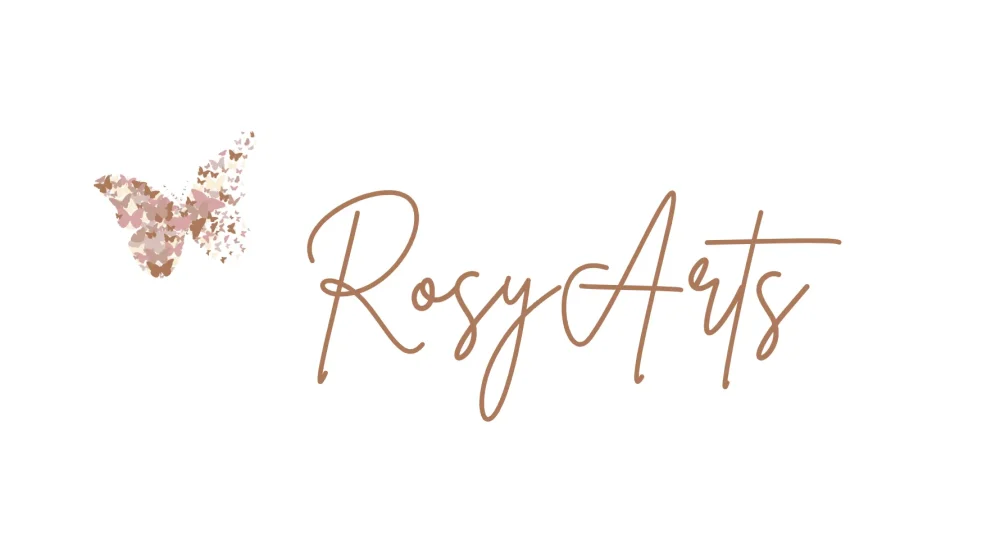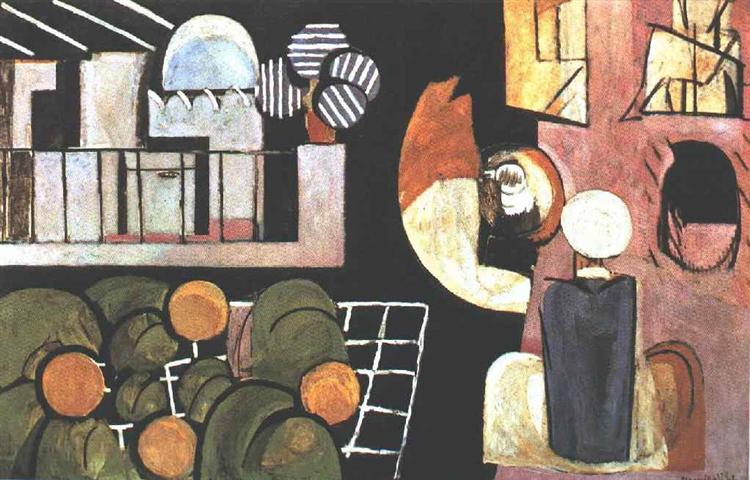在藝術史上,亨利·馬蒂斯(Henri Matisse)的名字與野獸派這種激進且充滿生命力的藝術風格緊密相連。馬蒂斯是一位顛覆傳統、勇於創新的藝術家,他以其鮮豔的色彩、簡單的形狀和強烈的表現力而聞名,為20世紀初的藝術界帶來了一股新的風潮,本文將透過走訪馬蒂斯的10部作品,來深入了解野獸派。
馬蒂斯早期
馬蒂斯出生於1869年,原本是一位研究法律的學生。然而,在一次生病中,他開始接觸畫畫,並深深地愛上了這種藝術形式,全心投入到藝術創作中。馬蒂斯開始在巴黎接受傳統藝術教育,並受到了印象派和新印象派的影響。然而,他並沒有完全遵循這些流派的規則,而是開始尋找自己的藝術語言。
馬蒂斯的早期作品顯示出他對顏色的敏銳感覺和對形式的大膽探索。他的畫作充滿了生命力和活力,顏色鮮明,形狀簡單而直接。這些作品預示了他後來在野獸派中的創作風格。
餐後餘景 La Desserte (1897)
這幅畫是馬蒂斯早期作品中的一個重要範例。畫面上,一張晚餐桌佈滿了各種物品,包括花瓶、盤子和水果,都被畫得栩栩如生。這幅畫展示了馬蒂斯對色彩和形狀的敏感度,早起作品很有印象派風格。
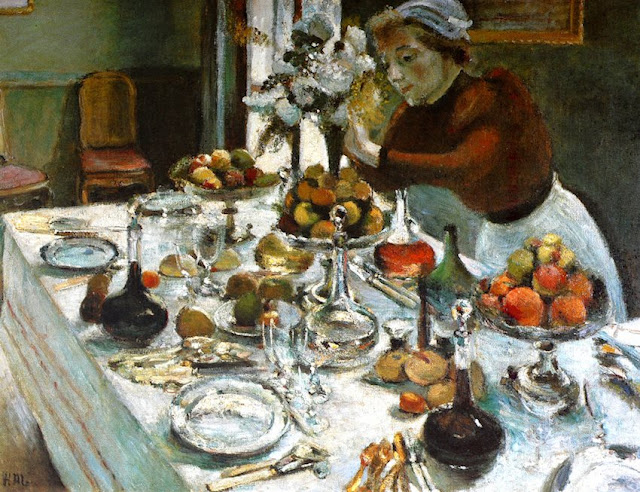
玫瑰色的牆 Le Mur Rose (1898)
又稱作粉紅牆。在這幅作品中,馬蒂斯運用柔和的色彩和簡單的形狀來描繪一座房子和周圍的風景。他的色彩運用和對形狀的簡化預示了他後來在野獸派風格中的創新。
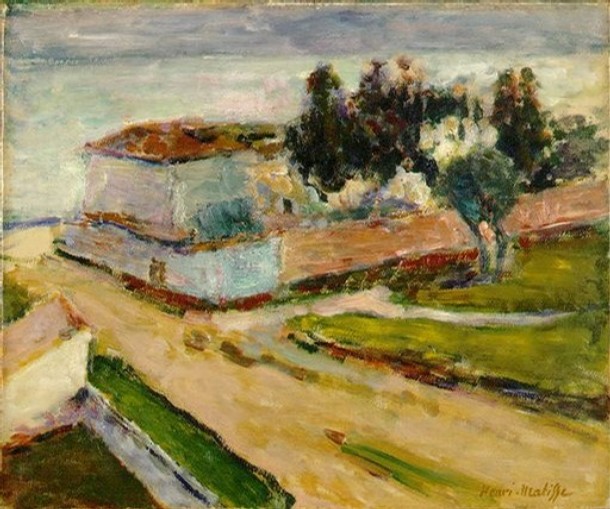
1905 秋季沙龍
在1905年的秋季沙龍中,馬蒂斯與他的藝術同僚,包括安德烈·德朗(André Derain)和莫里斯·德·弗拉米納克(Maurice de Vlaminck),展出了一系列極具創新性和活力的作品。這些作品以其對色彩的大膽使用和簡單的形狀而與眾不同,引起了公眾和評論家的廣泛關注。這些作品的鮮明特色促使了一位藝評家以「野獸」來形容這些藝術家,並因此而得名「野獸派」。
戴帽子的女人 Woman with a Hat (1905)
這是馬蒂斯在1905年秋季沙龍展覽中展出的作品,並且是他最有名的早期作品之一。畫中的女人就是馬蒂斯的妻子阿蜜莉。馬蒂斯用大膽、鮮豔的色彩來繪製她的帽子和衣服,這種色彩的運用引起了觀眾的強烈反應,這幅畫被認為是野獸派的誕生。

奢華、寧靜與歡樂 Luxury, Calm, and Pleasure (1904-1905)
是馬蒂斯使用點彩派技術的重要作品,這種技術主要是通過在畫布上巧妙地分佈色彩點,讓它們在遠處看起來像是融合在一起。馬蒂斯的風格則更偏向使用短短的色彩筆觸來構建形象。
這幅畫中的形式和細節的簡化是野獸派風景畫的特點,藝術家有意識地創造了一種扭曲現實的藝術結構。與馬蒂斯的作品相比,其他野獸派畫家的大型風景畫在構圖中並沒有那麼專注於人物。
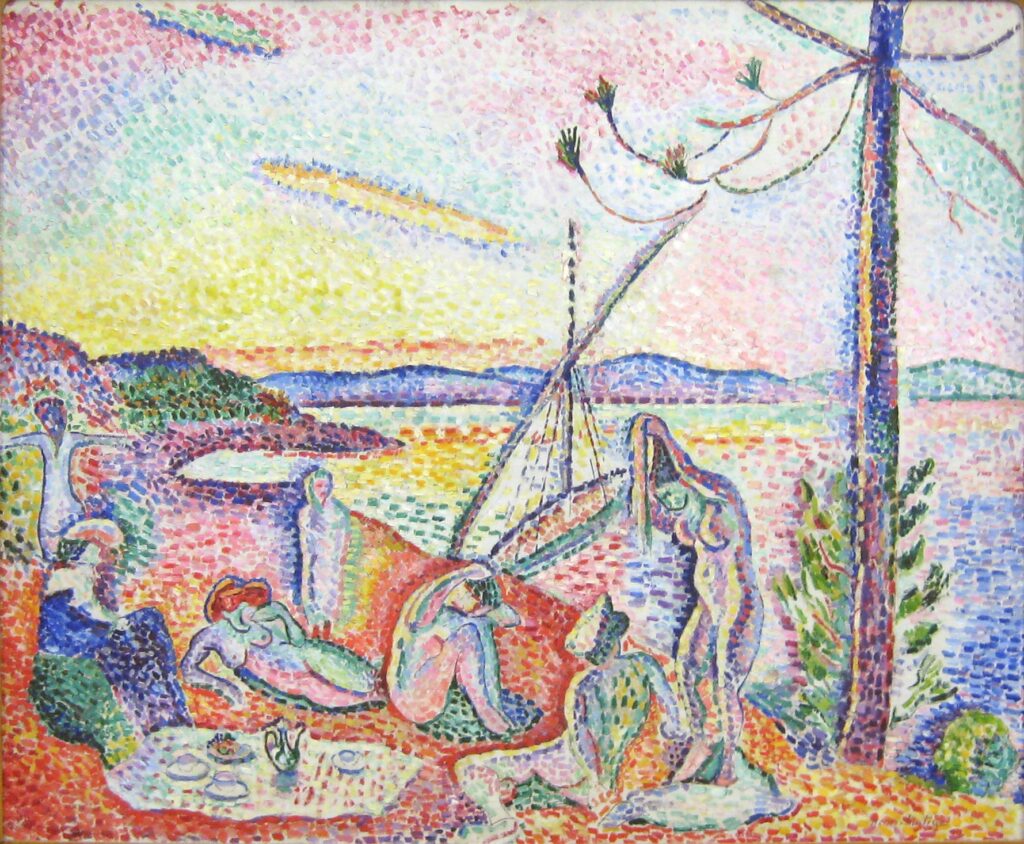
綠色條紋的馬蒂斯夫人 Portrait of Madame Matisse with the Green Stripe(1905)
這幅畫描繪的是馬蒂斯的妻子阿蜜莉。這幅肖像畫的最顯著特徵就是阿蜜莉臉部中央的綠色條紋,這是馬蒂斯對顏色傳統規則的大膽打破。他運用強烈對比的色塊和簡化的形狀,表現出他妻子的形象,而不是試圖真實地再現她的外貌。這種色彩和形狀的創新運用,在當時的觀眾中引起了強烈反應,標誌著野獸派風格的誕生。
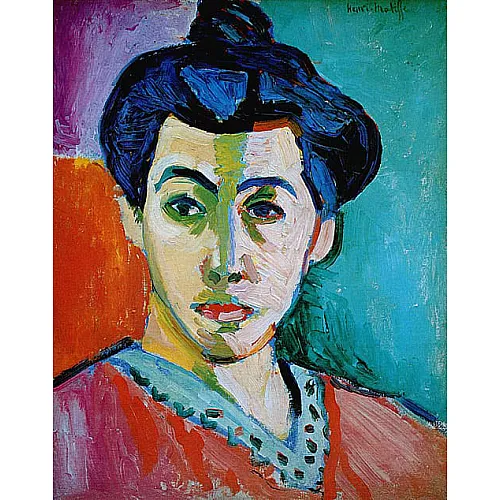
成熟
在這段時期,他的藝術風格開始呈現出更多的成熟與個性化,這從他對色彩更大膽的運用和形式的簡化上可以清楚地看到。
藍色裸女 Blue Nude (1907)
這幅畫作是馬蒂斯的標誌性作品之一,以簡單而鮮艷的藍色形狀構成的女性形象。馬蒂斯在此作品中以色彩和形狀來傳達情感,而非僅僅著重於對人體的真實再現。
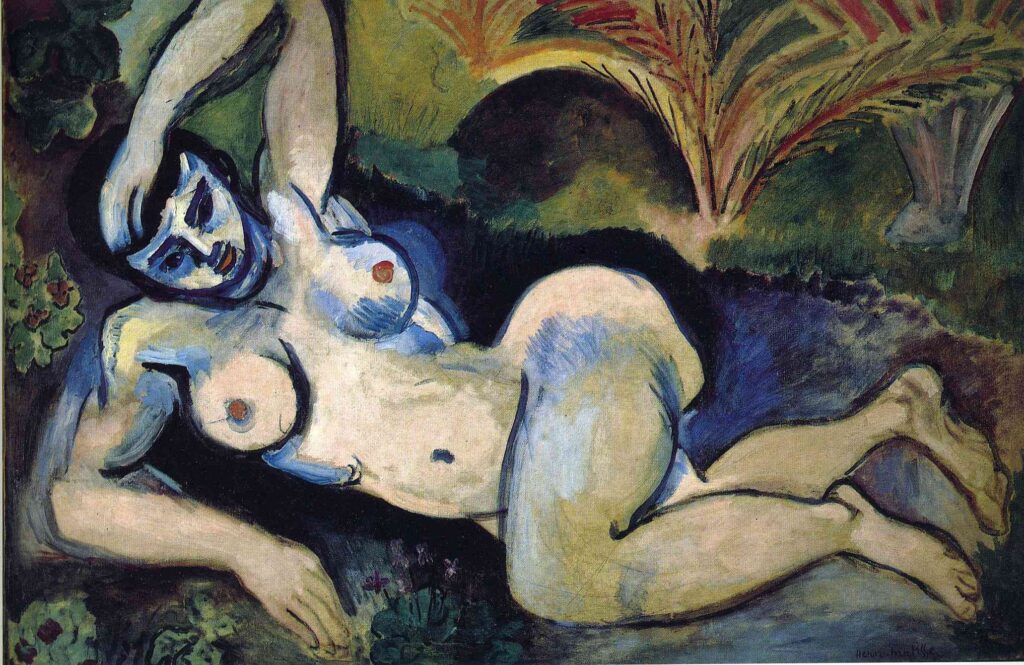
舞蹈 The Dance (1909)
舞蹈:這幅畫描繪了五個跳舞的人物,被塗成濃烈的紅色,背景是非常簡單的綠色景觀和深藍色的天空。它反映了馬蒂斯對原始藝術的初步迷戀,並使用了經典的野獸派調色板:強烈的暖色調與冷藍綠色背景和有節奏的連續舞動的裸體傳達了情感解放和享樂主義。這幅畫經常與斯特拉文斯基 (Igor Stravinsky) 1913 年著名音樂作品《春之祭》中的“少女之舞”聯繫在一起。
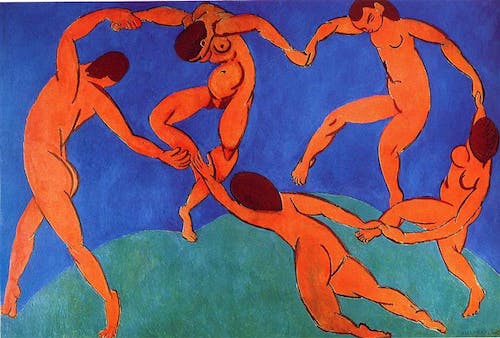
晚期馬蒂斯
在這個階段,他的風格變得更為純粹和抽象,並開始嘗試使用剪紙拼貼這種新的創作方式。
馬蒂斯晚期的作品完全脫離了他早期的風格,成為了他個人藝術語言的高峰。他的作品不再專注於對現實的再現,而是成為了他個人情感和視覺經驗的深刻表達。
鋼琴課 The Piano Lesson (1916, French)
這幅畫描繪了馬蒂斯的兒子皮埃爾正在彈鋼琴的場景。畫中的色彩和形狀都經過了極為抽象和簡化的處理,顯示了馬蒂斯對形式和色彩的深入探索。
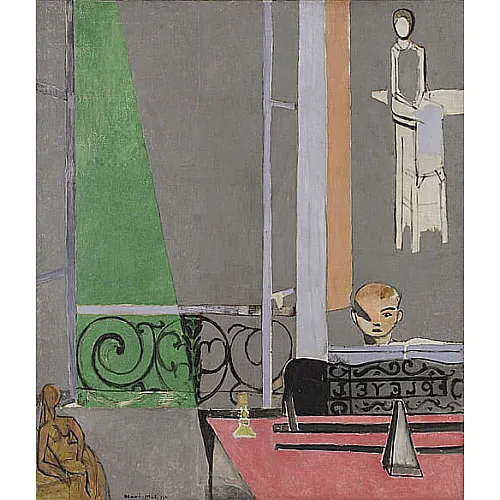
穿著紫色外套的女人 Woman in a Purple Coat (1937)
描繪了馬蒂斯的助手莉迪亞·德萊克托斯卡婭 (Lydia Delectorskaya)。這幅畫是亨利·馬蒂斯成熟裝飾風格的典範。她穿著異國情調的摩洛哥服裝,周圍環繞著複雜的抽象設計和異國情調的色彩。 馬蒂斯職業生涯中最後一組油畫,1950 年他停止畫油畫,轉而創作剪紙。
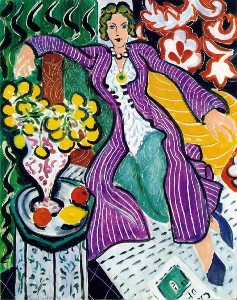
藍色裸女剪紙系列 “Blue Nudes” series (1952, French: “Nu bleu”)
這是馬蒂斯晚年的代表作品之一,也是他用剪紙拼貼創作的最知名的作品。這些作品展現了馬蒂斯對形式的極簡處理和對色彩的大膽運用。
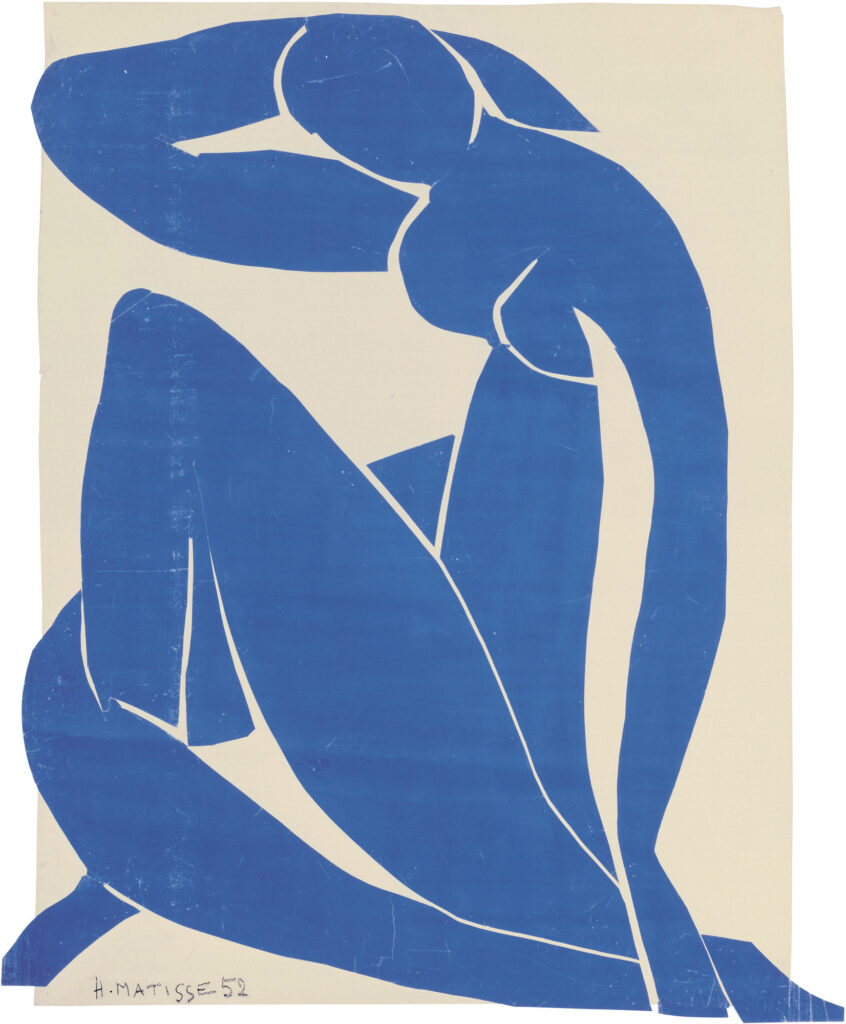
若喜歡我的文章也歡迎按讚、留言、訂閱及分享!
看更多藝術文章?歡迎到 RosyArts藝術專屬頁面
延伸閱讀 >>
[印象派名畫] 10部精選的印象派畫家作品!Impressionist | Monet、Manet、Pissarro
[普普藝術 Pop Art] 超詳解!起源、特色、知名作品一次看
